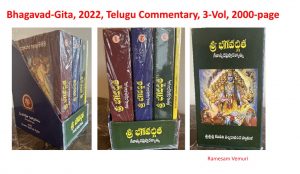[Part 1]
2. With One Stop Over:
Krishna reveals the universal rule, that governs with no exception, the next birth of a creature. The rule is:
यं यं वापि स्मरन्भावं त्यजत्यन्ते कलेबरम् ।
तं तमेवैति कौन्तेय सदा तद्भावभावितः ॥ — 8.6, BG.
Meaning: Of whatever Being thinking at the end a man leaves the body, Him alone, O son of Kunti, reaches he by whom the thought of that Being has been constantly dwelt upon.
Therefore, his promise is: “Whoso, at the time of death, thinking of Me (Vishnu, the Supreme Lord) alone, leaves the body and goes forth, he reaches My being (My real being as Vishnu); there is no doubt in this as to whether he reaches or not (8.5, BG; 7.30, BG.).” Continue reading


